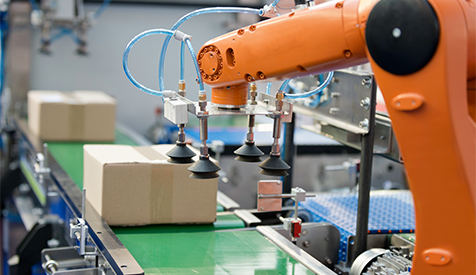Is warehouse automation the solution for managing growth in retail ecommerce?
As ecommerce scales and customer demands become increasingly complex, many retailers are opting for automated warehouse solutions to improve the efficiency of their ecommerce logistics operations and to drive down costs.
This blog explores the main benefits of warehouse automation, the different automation stages available and how to ensure a successful implementation.
What are the benefits of warehouse automation?
1 Reduced headcount Central to any automation business case is the headcount savings, driven by labour productivity improvements. Reduced headcount also allows the warehouse to scale without ‘draining’ the local labour pool. However, with the ROI for warehouse automation technologies often in excess of four years, labour cost reduction alone may not offer a sufficiently compelling reason to justify investment.
2 Improved space utilisation Automated storage solutions provide increased stock density compared to even the most space-efficient manual ones. By using the full height of the warehouse and greatly reducing or eliminating aisle space, the required footprint can be significantly reduced, which means lower rent costs or extending the life of an existing building.
3 Increased capacity and throughput Automation technologies are built to handle scale, and can significantly increase both storage and throughput capacity compared to a manual operation.
4 Improved accuracy Improved accuracy throughout end-to-end processes reduces costly errors for the retailer, and drives better service levels for the end customer.
Which stages of your fulfilment process are right for warehouse automation?
Automation is best suited to areas of greatest scale and degree of standardisation, with storage, picking and despatch the most commonly automated process areas. Here are some of the most common applications of warehouse automation within the key process areas of an ecommerce logistics operation.
1 Receiving Automated solutions for goods-in processes are heavily dependent on the degree of control a retailer has over its inbound supply chain and the typical inbound order size. With inbound typically accounting for less than 10% of direct labour hours within a manual operation, the ‘size of the prize’ for automation is relatively small.
2 Storage and retrieval Automated storage and retrieval systems (AS/RS) deliver denser, more space efficient options with the flexibility to grow as the business grows. Naturally, the type of products handled, range size and location types need to be considered when choosing an appropriate approach.
3 Picking Generally the costliest part of an operation, picking lends itself to automation. Solutions can either be incorporated into AS/RS solutions (goods-to-person picking) or exist as an automated/manual hybrid (e.g. batch or zone picking with sortation).
4 Packing Direct-to-consumer order packing is another area that is costly and time consuming and often requires a high degree of co-ordination, especially if multiple handling types are required. Suppliers offer a range of solutions in this area, and help prevent packing from becoming a bottleneck in the rush to hit increasingly shorter delivery lead times.
5 Sortation and despatch Automated sortation and despatch solutions are relatively easy to integrate into warehouse processes, and have been successfully used by retailers and parcel couriers for 30+ years. Most direct-to-consumer retailers of scale deploy despatch sortation automation, which becomes particularly attractive when sorting parcels for multiple carriers and carrier services.
6 Returns Returns automation is less widely deployed, although several solutions exist. These are mostly targeted at online fashion retailers whose returns rates can be as high as 25%.
How do you ensure a successful warehouse automation implementation?
Automation implementations are significant, complex and costly transformation projects; here are five key considerations to avoid potential pitfalls and ensure success.
1 Clearly define the planning base and own the automation design The planning base (future business volumes, range, stock, and service requirements) should be clearly defined and agreed, based on the business strategy and growth projections. During selection, the retailer should ensure vendor solutions can meet business requirements, budget and timelines, and post selection, close management of the solution and team buy-in are essential.
2 Deliver small projects and test regularly A leap of faith into the unknown will not render results – rather, phased implementation to manage risk, delivering smaller projects and testing regularly is the ideal route.
3 Get the systems right The solution design should not be over-complicated or limit future flexibility and the IT architecture should be clear and simple. In particular, the function and integration of the warehouse management system and warehouse control system need to be very carefully planned.
4 Ensure strong programme management, communication and governance The programme director should maintain the scope, spend, timelines and communications strategy. Key stakeholders within the business, particularly in buying and merchandising, need to understand why warehouse automation is needed and share the vision.
5 Manage culture change Automation, in practice, should make an operation cheaper and faster. In reality, the business needs to accept a new way of working for the benefits to be realised, and the whole supply chain move to a more ‘manufacturing’ way of working.
To read the full report DOWNLOAD White Paper: Do retailers need warehouse automation?
For further reading on this topic, read Accenture’s report Re-route your strategy for last mile delivery
FIND OUT MORE about Javelin Group’s Operations service line.
